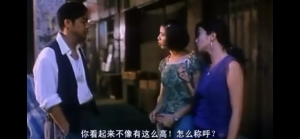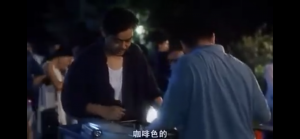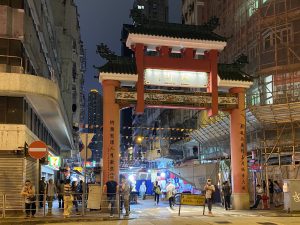C’EST LA VIE, MON CHÉRI, DIR. Derek Yee Tung Sing (1993)
YAU MAA TEI, Yau Tsim Mong District, HK

This is the first time Min and Kit stand face to face, in front of their tenement in Yau Maa Tei and with the background of the space of everyday life on the Temple Street. Scenes from C’est la vie, mon chéri (1993), directed by Derek Yee.
C’est la vie, mon chéri is a 1994 Hong Kong romance movie directed by Derek Yee.1 In the movie, Kit (acted by Lau Ching-wan) is an unrecognised jazz talent who finds his life struggling for not being commercially successful. Kit moves to a tenement in Yau-Maa-Tei, where Min (acted by Anita Yuen), an Cantonese Opera performer, lives downstairs. Min suggests Kit to give up his stubbornness on jazz music and cater to the blooming market of pop. Kit accepts Min’s idea because he loves Min, but when he is marching to his success, Min dies of relapsed born cancer. The movie sets in the old town of Yau-Maa-Tei, especially on the Temple Street area which famous for street performances (Min performs there as well). The “place” and “space” in the Temple Street area fit the movie’s settings and create a place of everyday life and a place of events.2
In the movie, the Temple Street area is highlighted with its brightness and splendidness. It has an atmosphere of night life: the lights and neons light up the area, with a number of stalls and stands that attract all the walkers to stop and take a look. At the same time, several stalls also set up small stages for making performances, including Min’s family who set up a small but cozy space for performing opera. In the reality, the Temple Street area is also crowded and lively, with a lot of stalls selling fruits, vegetables and small items. Unfortunately, there are rarely street performances currently due to the pandemic, and this commercial area temporarily losses one of its most attractive events. At the same time, the nearby area Tung Choi Street is depicted differently in the film and in the reality. Tung Choi Street is famous for stalls that sell goldfishes, and in the film when Min and Kit tour on this street, the stalls are open-air and the goldfishes are packed in plastic bags, but now there are only indoor shops left and the goldfishes are kept in aquariums.
The Temple Street area and Min’s stage for her performs work as a “space” for the film. Min performs opera on the stage every night, defining the stage as a space of everyday life with a “proper”for Min.2 It is also a “practical place” for Min which depicts her career and shows her life’s progress.2 Besides, a comparison is presented between Tung Choi street, working as a place of everyday life, and the hospital Min lives in, as a place of event.3 When Min comes to her life’s extremity, she wants to eat rice pudding and Kit goes to Tung Choi Street to buy it. A cross-cutting shows both Kit’s and Min’s surroundings: Kit is walking on the bright and crowded street, which shows the normality of life; while Min is lying on a hospital bed in a dark and quite environment, showing the occurrence of a strange event, which is her death.3
— Shuntian Tan 3035777585


- This is the comparison between space of everyday life and space of event in the film. On the left, Kit is buying rice cake for Min, who wants to have her last bite of rice cake in her life; On the right, Min is lying on her bed in a hospital when her life is coming to an end. Scenes from C’est la vie, mon chéri (1993), directed by Derek Yee.


On the left is the gate of the Temple Street, where the film mainly based on. This shows the consistency between the film and the reality that the temple street is always crowded and lively at night. On the right is the Tong Choi Street, which is also known as Goldfish Street. In the film, the goldfish are sold in open-air night fairs, but now there are only in-door aquariums. Comparison between real life and scenes from C’est la vie, mon chéri (1993), directed by Derek Yee.
References:
1 Bastian Meiresonne, “VIVA EROTICA: L’INDUSTRIE DU FILM À HK,” HKMDB. February 22, 2004. Accessed on March 4, 2021. http://hkmdb.com/db/movies/view.mhtml?id=7752&display_set=eng.
2 De Certeau, M. (1984). Spatial Stories. In The Practice of Everyday Life (pp. 115-118), translated by Steven Randall. Berkeley: University of California Press.
3 The concepts are noticed from “Lecture 4: Urban Everyday Spaces as Narrative” and “Lecture 5: Urban Infrastructure as Event”.
Your careful analysis of the places in the film with regard to the pandemic is appreciated. Could the pandemic, a sporadic event in time, be drawn to compare with the performance on Temple Street that only occurs at night? The unexpected relapse of Min’s cancer can also be discussed with the suddenness of Covid-19. Cancer stopped her from performing with the pandemic paused performance on street. You could be more imaginative to draw relations between real-life events and the film to discuss space and time. Moreover, it would be great if you could elaborate on the space/ place idea of Min’s stage. Why is it important to bear both meanings? How did Min use the stage as her space and how did that help to narrate the story? To talk about place and space it is not only important to define it but also to analyze how the concepts are utilized in the film.